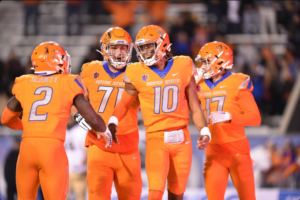

The anticipation for the upcoming Big 12 Football Media Days at Allegiant Stadium in Las Vegas is palpable as fans, coaches, and players gear up for the event scheduled on July 9th and 10th. This year’s media days hold particular significance as the conference bids farewell to longstanding members Texas and Oklahoma, while embracing new arrivals Utah, Colorado, Arizona, and Arizona State.
The departure of Texas and Oklahoma marks the end of an era for the Big 12, known for its fierce competition and storied rivalries. These teams have been pillars of the conference, consistently setting high standards both on and off the field. Their absence creates an opportunity for other programs to rise to prominence and redefine the conference dynamics.
Utah, Colorado, Arizona, and Arizona State bring a fresh perspective and competitive edge to the Big 12. Utah, renowned for its strong football tradition in the Pac-12, enters the conference with aspirations to continue its winning ways and establish new rivalries. Colorado, returning to familiar territory after a stint in the Pac-12, aims to recapture its past glory and make a mark in the Big 12 landscape. Meanwhile, Arizona and Arizona State inject southwestern flair and bolster the conference’s footprint with their passionate fan bases and commitment to athletic excellence.
Against this backdrop of change and renewal, the Brigham Young University (BYU) Cougars find themselves at a crossroads following a disappointing 2023 season. In their inaugural year in the conference, BYU struggled to find consistency, finishing with a 5-7 overall record and a challenging 2-7 mark in conference play. Despite a promising 5-1 start, the Cougars faltered down the stretch, failing to secure a road victory in conference matchups, which ultimately marred their season.
Looking ahead to the 2024 season, BYU is determined to rebound from last year’s setbacks and assert itself in the competitive landscape of the Big 12. However, national and conference expectations remain tempered, with ESPN’s Football Power Index (FPI) ranking BYU 15th, and Athlon Sports placing them slightly higher at 14th. These rankings reflect skepticism about BYU’s ability to significantly improve upon its previous performance without substantial evidence of a turnaround.
The coaching staff under Kalani Sitake faces the challenge of leveraging last season’s experiences to propel the team forward. With key players returning and a renewed focus on development and strategy, BYU aims to exceed expectations and prove its critics wrong. The Cougars must address issues that plagued them last season, particularly in road games and late-season consistency, to avoid another disappointing finish.
Despite the doubts surrounding BYU, there is recognition of the depth and competitiveness within the Big 12 conference. Traditional powerhouses like Oklahoma State, fresh off an appearance in the Big 12 Championship Game, and Kansas State, which finished 18th in the AP poll last season, continue to set the standard for excellence. Arizona’s impressive 10-3 record and Kansas’ resurgence to a 9-4 season highlight the breadth of talent and potential within the conference.
Moreover, new entrants like Utah are eager to make their mark and assert themselves in their maiden season in the Big 12. Utah’s recent challenges with injuries are seen as a temporary setback, with the return of key players like Cam Rising expected to bolster their competitiveness. The Utes aim to replicate their success from previous seasons, including back-to-back Pac-12 titles, as they navigate the transition to a new conference.
As BYU prepares for the upcoming season, their schedule presents a daunting challenge with matchups against formidable opponents from within the Big 12. Teams like Oklahoma State, Kansas State, and Arizona pose significant obstacles, while games against West Virginia and Iowa State, both known for their resilience and competitive spirit, further test BYU’s resolve.
In assessing BYU’s standing within the conference, comparisons with teams like Baylor, Arizona State, Cincinnati, Colorado, and Houston highlight the competitive parity within the middle tier of the Big 12. Baylor and BYU faced similar struggles last season, showing promise early on but faltering down the stretch. Arizona State and Colorado, transitioning from the Pac-12, also seek to improve upon disappointing performances in their respective previous conferences.
Looking ahead, BYU must capitalize on opportunities for growth and improvement across all facets of their game. Whether it’s Jake Retzlaff’s development, Gerry Bohanon’s leadership, or enhancements in offensive line play and defensive strategies under Jay Hill, the Cougars must demonstrate tangible progress to ascend in the Big 12 rankings. Until then, BYU finds itself cautiously positioned in the middle of the pack, striving to exceed expectations and elevate its status within a competitive conference landscape.
As Big 12 Football Media Days approach, the spotlight remains firmly fixed on Allegiant Stadium in Las Vegas, where narratives of renewal, redemption, and rivalry will unfold. For BYU, this event represents more than just a platform for preseason prognostications; it’s an opportunity to rewrite their narrative, redefine expectations, and reclaim their competitive edge in the fiercely contested arena of Big 12 football.

Leave a Reply